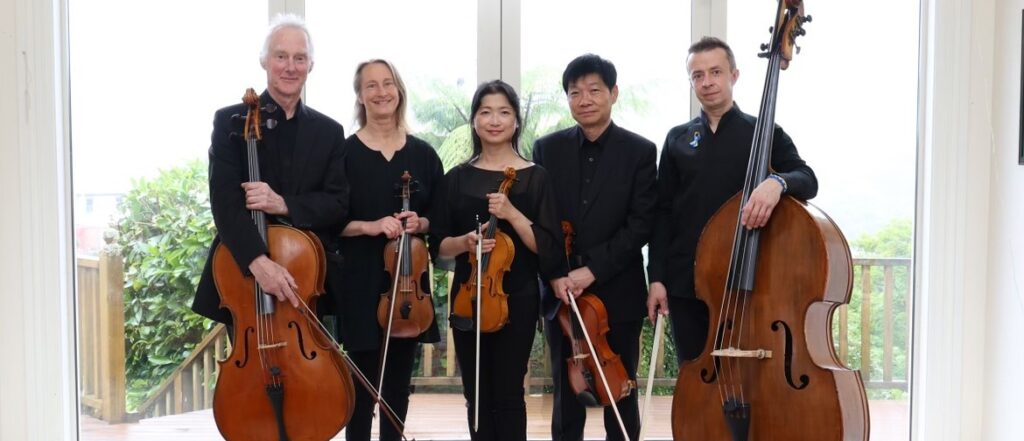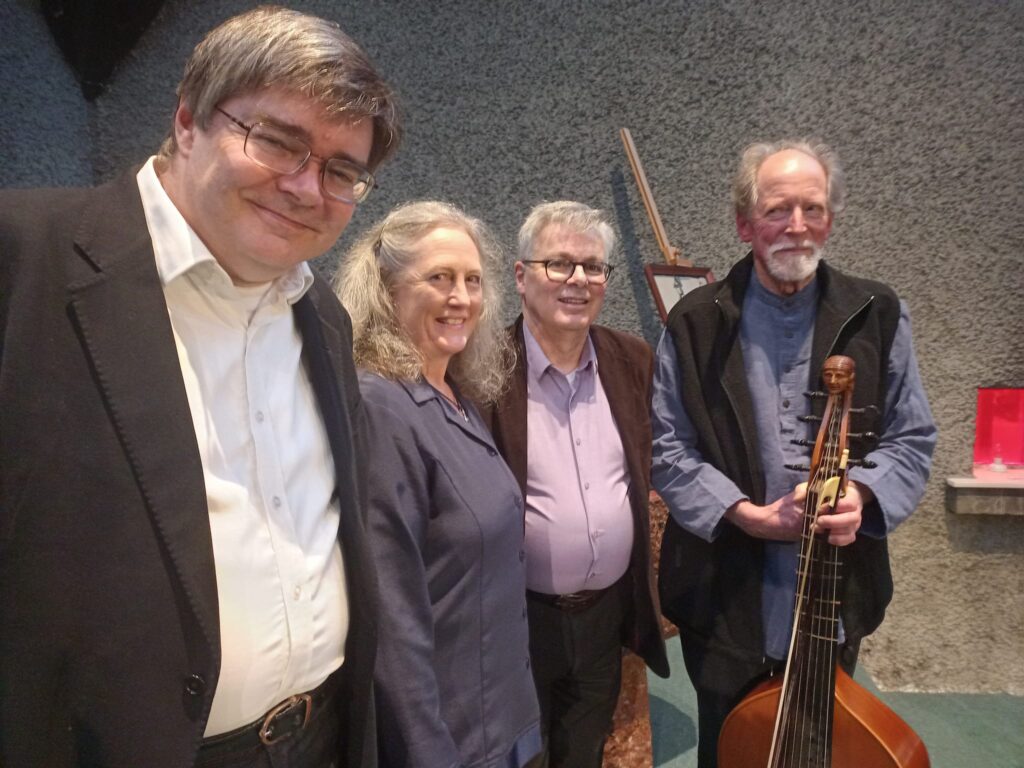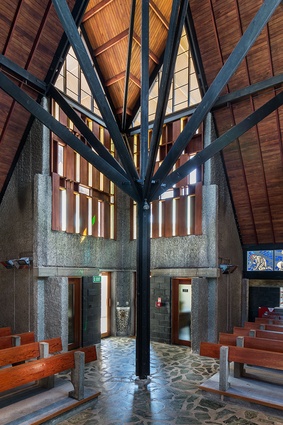The Aroha Quartet, with Oleksandr Gunchenko

GEORGE ONSLOW – String Quintet No.15 in C Minor Op.38 “The Bullet”
LOUISE WEBSTER – Swim the Sliding Continents (2012)
ANTONIN DVOŘÁK – String Quintet No. 2 in G Op.77
Aroha Quartet – Haihong Liu (leader), Konstanze Artmann (violin), Zhongxian Jin (viola)
Robert Ibell (‘cello)
– with Oleksandr Gunchenko (double-bass)
St.Andrew’s-on-The-Terrace, Wellington
Friday, 12th July, 2024
I had heard the name George Onslow mentioned in various reviews of recordings over the years, but had never “taken the plunge”, being culpably averse to taking up the music of any “new” composer unseen or unheard – I must admit to a sneaking propensity for the “bowled over by something new” experience in such matters, which is exactly what happened on Friday evening at St.Andrew’s in Wellington, with a first hearing of one of Onslow’s String Quintets, sensationally presented by the Aroha String Quartet with double-bassist Olelsandr Gunchenko.
This was the composer’s Fifteenth String Quintet, and one bearing the title “De la balle” (The Bullet), whose inspiration was drawn from Onslow’s experience of being accidentally shot in the face while watching a hunt in a forest. While not exactly programmatic as to the actual event, the different movements delineated an almost Berlioz-like reimagining of what was obviously a life-threatening personal experience, the second movement (Minuetto: dolore – suffering) and a Trio (febbre e deliro – fever and delirium), the third Andante sostenuto – convalescenza), and the triumphal finale (Allegro – guarigione) healing. I was left stunned by the impact of it all, and, not unexpectedly, resolved to explore some more of this fascinating figure’s output to make up for what I might well have been missing for all these years!
It was actually a guilty pleasure (not always the case!) to re-read my notes afterwards, written at the same white heat as the performers were generating, simply by way of trying to “keep up” with what was happening! – I enjoyed the C-minor opening of the work’s suitably dark, cavernous sound, with the voice of the double bass adding to the textures, and contrasting markedly with both the brilliant violin figurations, and the beautiful second subject solo from the ‘cello. The music made much of these contrasts throughout, with upper strings suggestively elfin disturbances, and the lower strings bringing darker intensities to the argument. Then came that astonishing Menuetto with its opening whirlwind figurations and spectral tones, creating a almost Gothic mini-scenario with eerie chromatic resonances and sudden outbursts, and the Trio’s “Febbre e delirio” deliciously feverish in effect!
The Andante sostenuto brought some relief (the programme note termed it “hymn-like”) suggesting a release from “the nightmare”, which the work’s final movement confirmed in no uncertain terms with its vibrant, over-the-top “Convalescenza” (a lovely word!), evoking a polar-opposite exuberance to the travails of what had gone before, and to which I couldn’t help at one point but laugh out loud, to the surprise of my neighbours! Afterwards I had to apologise to at least one of them, my excuse being that I thought the music sounded as if it had been composed on “speed” or something similar!
Not for the first time this year have I found myself jumping on the internet at home after a concert, and (in this case) almost as feverishly looking for a recording of the Quintet, at which point I was surprised again by how many recordings WERE actually available of George Onslow’s music, and not merely his Quintets. As I sent off my order to make good my discovery, I felt something along the lines of what Allen Curnow once wrote in a different context– “Simply by sailing in a new direction you could enlarge the world…..”
Ahem! – were there other works played at this concert? – oh, yes! – my apologies! Different worlds again, to be sure, and as an assemblage rich and strange, though of course united in instrumentation.
An interval after the Onslow did allow the more fanciful souls present (such as myself) to regain their composure before the second half brought us a work by New Zealand composer Louise Webster, one written originally for a school chamber orchestra from Auckland’s Westlake District Schools, “Swim the sliding continents’.
The work’s title was suggested by some lines from a poem by Australian Judith Wright, words which expressed movement through both air and water, “swimming , floating and drifting above lands/ gulfs/chasms…..” as the programme notes put it. At once sparely and concentratedly written, the work began with the direction “drifting” for a violin solo and double bass and cello pizzicato, the violin accelerating, impassioned, and joined by an ostinato from the second violin, to various responses from the others rising from the depths. When movement was stilled, there were haunting passages of different voices, the first violin rarefied, the second repetitive and mesmeric, the viola and cello echoing certain phrases and the double bass a deep-voiced bedrock foundation – a brief two-violin-voiced coda, and the piece ended, suggesting for me rather more than it actually spoke.
Having explored what could be considered two diametrically opposed ends of the emotional spectrum in music, George Onslow’s almost Gothic horror-adventure complete with its Disney-on-steroids ending and Louise Webster’s cool abstractions of tectonic relocation, the Aroha Quartet with its distinguished guest Oleksandr Gunchenko opted for some middle ground with the concert’s final item, Antonin Dvorak’s single String Quintet that uses a double-bass, his Op.77 in G. This work, originally composed in 1875 with five movements, was published as Op. 18, but then revised by the composer with an “intermezzo” movement removed (and later republished). Dvorak’s publisher then gave the Quintet the later Opus No. of 77, a ploy Simrock was fond of using to persuade people that certain works of the composer’s were more “mature” than was the case.
While this work has never been one of my favourites of the composer’s (for me the second and fourth movements lack the melodic and rhythmic attractiveness of the rest) the quintet of players here obviously felt no such impediments as they by turns attacked, caressed, sang and danced to the music with a will. The first movement in particular leapt gleefully off the pages to our ears, the players’ strong and flexible pulses bringing out both the music’s leaping, thrusting character, and the rustic charm of the more lyrical passages – particularly wonderful was the final reprise of the principal theme and its acceleration into the excitement of the coda!
The players did their best with the somewhat repetitive scherzo, the best part of which was the winsome Trio sections whose swaying motions charmed the ear more than usually – but the performance really “glowed” with the slow movement’s gorgeous singing cello melody, and rapturous first violin responses which reprised beautifully with triplet decorations later in the movement – for me the performance’s highlight! But however much energy the players put into the rhythms of the finale, I remained puzzled by the composer’s reluctance to turn to anything more than variations of downward scales for lyrical effect to go with the generated excitement of the movement’s trajectories.
I’m reminded of a story I once read about Handel who reputedly once looked at a manuscript by a contemporary of his, one Maurice Greene, before opening the window and dropping it outside with the remark that “it needs air!” – by which, of course, he meant melody. Dvorak’s music normally doesn’t “need air” of any kind, in my usual experience, hence my relative disappointment here, and especially in tandem with all that rhythmic energy. Of course one doesn’t have to like EVERYTHING any composer does, and judgements of this kind can be subjective and ornery, and there was, as I’ve said, absolutely nothing lukewarm about the players’ response throughout. The rest of the evening’s music produced untrammelled delight– and in the case of Onslow’s music it was the sort of musical discovery one would, as a friend of mine was fond of saying, die for! So, my thanks are due to the Aroha Quartet and Oleksandr Gunchenko for their wondrously committed efforts, and especially in bringing to life music whose sounds I felt “enlarged my world” that evening.
 David Morriss (bass), Pepe Becker (director, soprano), Douglas Mews (keyboards), Robert Oliver (bass viol)
David Morriss (bass), Pepe Becker (director, soprano), Douglas Mews (keyboards), Robert Oliver (bass viol) Futuna Chapel, Karori
Futuna Chapel, Karori